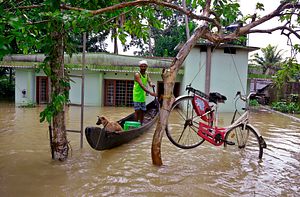The cycle continues in India: Kerala is the site of extreme flooding this time. The damages – already more than 350 people dead, roughly 906,000 hectares worth of crops destroyed, and more than $3 billion in costs estimated – continue to rise. Local, state, and central governments are all responding to the situation. Yet citizens are outraged at the bureaucracy for not taking pre-disaster actions to prevent mitigation failures. The disaster will conclude, and recovery will begin. Life will go on – until the next deadly flood starts the cycle all over again.
This unfortunate sequence of events for the state of Kerala is regular every monsoon season in India. Despite the central government’s shift from a reactive, response-centric approach to a more proactive and holistic, mitigation approach, the end result, in terms of immense physical and economic damages, is more or less the same. True, blame for the shortcomings in India’s disaster management does not rest squarely on the shoulders of New Delhi. State governments and district administrations have responsibility to bear, namely when it comes to the problems of increased urbanization, crumbling infrastructure, and outdated technology. Moreover, the increasing frequency and intensity of natural disasters in South Asia result from climatological pressures. However, part of every disaster mitigation problem, whether at the central or local level of Indian government, is the lack of political will to act. Here, New Delhi must take charge and resolve this issue.
Namely, New Delhi has yet to comply with all the statutory requirements of the Disaster Management Act (DMA) of 2005, the seminal piece of legislation on this issue. Currently, there is not a National Disaster Mitigation Fund (NDMF), even though the DMA of 2005 stipulates the creation of one under Section 47. The Ministry of Home Affairs, which oversees the NDMF, has argued that the “need for creation of a separate NDMF has not been felt” because the central government allocates money to other departments and agencies to carry out disaster mitigation projects.
However, not setting aside a protected, yearly guarantee of funds, such as the NDMF, risks making necessary mitigation projects vulnerable to budgetary cuts and political whims. Similarly, by not complying with this section, the central government looks hypocritical if it tries to compel state governments and district administrations to set up their own disaster mitigation funds, as is mandated under Section 48. In turn, state governments and district administrations strapped for cash may look to rehabilitate damaged structures instead of demolishing them to build new, disaster-resilient ones.
Besides not complying with statutory requirements, the central government has not yet brought state governments and district administrations into full compliance with the DMA of 2005. For instance, as of May 2017 – 12 years after the act was passed — 10 percent of districts still had not completed and certified disaster management plans, as is required under Section 31.
In turn, due to this weak enforcement, state governments and district administrations may not act urgently after a natural disaster to ensure disaster mitigation measures are put in place before the next one. For example, critical public infrastructure projects require disaster management plans in the event of a calamity. But, according to a July 2017 performance report by India’s Comptroller and Auditor General, only 349 out of 4,862 of India’s large dams have emergency disaster action plans in place. Also, only two states out of 17 have carried out pre- and post-monsoon inspection of the dams within their area of control. These gaps in readiness at the state and district levels over flood management are concerning given that floods so far in the last decade have affected more than 91 million people in India and have cost at least $30 billion, according to data from the International Disaster Database.
New Delhi must comply with all statutes and ensure that state governments and district administrations do as well. However, the DMA of 2005, for example, has been in place for 13 years and problems related to compliance and funding still exist. The central government needs to have the political will to act and enforce the law.
Developing the necessary political will to tackle a problem is partly affected by how political actors perceive that problem. If they perceive it as essential but not urgent, policymakers constrained by time and monetary considerations may not take immediate action. The longer this action is prolonged, the more likely the problem will go unresolved.
Prime Minister Narendra Modi perceives disaster mitigation, referred to as “disaster risk reduction,” as having a pivotal role in supporting sustainable development. With the word “development” suggesting long-term, rather than immediate, change, the central government may not feel the need to act as urgently unless there is a momentary uproar from the citizenry. Thus, Modi, as the leader of the central government, must find a way to change the perception behind disaster mitigation to spur the bureaucracy at all levels into action. If the political will to at least enforce the laws on the books does not materialize, then how can civil society, state governments, and district administrations trust that New Delhi is committed to reducing disaster risk? It won’t. The cycle will repeat.
Neil Noronha was a former Henry Luce Scholar affiliated with Carnegie India. He also worked in the Obama Administration on the National Security Council Staff and at the Department of Defense. He tweets at @NeilNoronha2.

































